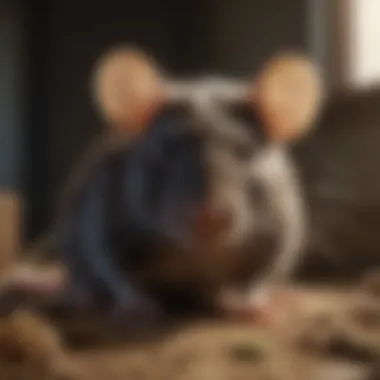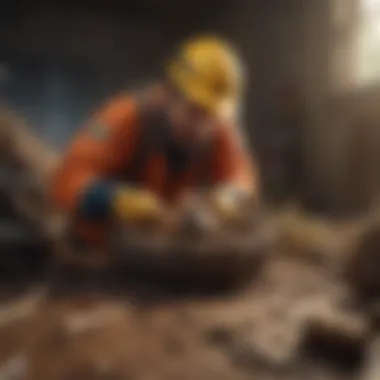Proven Strategies for Effective Rat Nest Removal


Intro
Rats pose significant challenges to both residential and commercial properties. Understanding their behavior and the implications of their presence is crucial for effective management. Rat nests can lead to property damage and health risks, making it essential to adopt strategies that not only eliminate these nests but also prevent future infestations. This article will explore various methods for rat nest removal, the importance of preventive measures, and eco-friendly practices in pest control, providing a comprehensive guide for homeowners and pest control professionals alike.
Understanding Pests
Definition of Pests
Pests are organisms that disrupt human activities, typically by infesting structures or by damaging crops. In urban environments, rats are among the most common pests, thriving in various conditions. Their adaptability makes them particularly troublesome, as they can inhabit both indoor and outdoor areas, often unnoticed until severe damage or health threats arise.
Importance of Pest Identification
Identifying the specific pest is crucial in formulating an effective response. Not all rodent species exhibit the same behavior or require the same removal strategies. For example, Norway rats and roof rats have different nesting habits and behaviors. Proper identification enables targeted approaches in pest control, enhancing the likelihood of successful elimination.
Prevention Techniques
Home and Garden Preventative Measures
Implementing preventative measures is essential in reducing the risk of future rat infestations. Key strategies include:
- Sealing Entry Points: Examine the property for gaps or openings. Even small cracks can serve as entry points.
- Proper Waste Management: Dispose of garbage securely. Use bins with tight-fitting lids to avoid attracting rats.
- Landscaping Practices: Keep vegetation trimmed and clean. Rat nests often form in dense tangle and debris.
Seasonal Prevention Tips
Specific seasons may present heightened risks for rat infestations, particularly winter when food and warmth are sought. Adapt your strategies accordingly:
- Autumn: Inspect and repair any structural weaknesses as rats prepare to enter homes for shelter.
- Winter: Ensure that all food sources are securely stored. No open food scraps should be left outside.
Eco-Friendly Pest Control Solutions
Overview of Sustainable Practices
Adopting eco-friendly pest control solutions is not only beneficial for the environment but also effective. Sustainable practices include:
- Utilizing non-toxic traps and baits.
- Encouraging natural predators, such as owls or even snakes, by creating a suitable habitat around the property.
Natural Remedies and Their Effectiveness
Several natural remedies can deter rats effectively. Some popular options include:
- Peppermint Oil: Its strong scent may repel rats if applied around entry points.
- Diatomaceous Earth: This natural powder can be sprinkled around nesting areas to deter rats without causing harm to the environment.
"Implementing eco-friendly practices allows for a sustainable balance between pest control and environmental conservation."
Understanding and addressing the problem requires a multi-faceted approach. The importance of early identification, proactive prevention, and sustainable management cannot be overstated. By understanding rat behavior and employing effective strategies for nest elimination, property owners can maintain a healthier, safer environment.
Understanding Rat Nests
Understanding rat nests is a crucial element in controlling rodent populations effectively. Rat nests can indicate larger infestations and can lead to significant health risks. By knowng the characteristics, common locations, and signs of infestation, homeowners can take appropriate action. This section sheds light on the nature of rat nests and the insights that can assist in dealing with these pests.
Definition and Characteristics
A rat nest is a constructed dwelling used by rats. It is typically made from various materials, including shredded paper, cloth, insulation, and even leaves. Rats tend to build their nests in secluded areas where they feel safe. Among their characteristics is a noticeable odor, which could be due to urine and feces accumulation. The nests can vary in size, often larger for larger populations, and are frequently found in dark, undisturbed places within the property.
Common Locations for Rat Nests
Rats prefer locations that provide shelter and access to food. Common areas to find rat nests include:
- Attics: Quiet and insulated spaces are perfect for nest-building.
- Basements: Dark and damp areas attract rats due to their proximity to moisture.
- Wall voids: Cavities within walls provide concealment.
- Outdoor spaces: Burrows near foundations, gardens, and landscape mulch can harbor nests.
It is essential for homeowners to check these locations regularly, especially in urban areas where food sources may attract rats.
Signs of Infestation
Identifying the signs of rat infestation can facilitate timely and effective intervention. Key indicators include:


- Droppings: Fresh rat droppings are dark and cylindrical, often found in areas where rats travel.
- Gnaw marks: Signs of chewing on wires, furniture, or food packaging indicate a rat's presence.
- Tracks: Dusty areas can show footprints or tail marks.
- Noises: Sounds of gnawing or scratching, especially at night, can suggest activity.
"Quick identification of these signs can prevent severe infestations and related damages."
Recognizing these symptoms allows for swift action, reducing the risks associated with rat populations and maintaining a healthy home environment.
Behavioral Patterns of Rats
Understanding the behavioral patterns of rats is critical in the context of effective pest control. Their behaviors dictate not only the locations they choose for nesting but also their feeding habits and how they interact with their environment. Comprehending these behaviors informs strategies for eliminating nests and preventing future infestations. This knowledge serves as a foundation for homeowners and pest control professionals alike, enhancing their ability to navigate and deal with rat-related issues.
Breeding Habits
Rats are prolific breeders and can reproduce several times a year. A female rat can give birth to litters of up to twelve pups, with the potential for two to three litters annually. This rapid reproduction rate significantly contributes to the speed at which a rat infestation can grow. Typically, breeding peaks during warmer months, though indoor environments can sustain breeding year-round.
Understanding this aspect is essential for removal strategies. If a nest is not dealt with promptly, the population can expand quickly, making future control efforts more challenging. Therefore, identification of breeding sites and early intervention are key in managing and mitigating infestations.
Feeding and Diet
Rats are omnivorous and have a very adaptable diet. They consume a wide range of foods, from grains and fruits to refuse and scraps. Understanding their feeding habits helps in developing effective ways to disrupt their access to food sources. For instance, if food is readily available, rats are more likely to remain in an area and multiply.
To manage an infestation effectively, it is necessary to eliminate food sources. This includes securing trash, cleaning up spills promptly, and storing food in sealed containers. By understanding their dietary preferences and behaviors, homeowners can better strategize against rats and minimize their attraction to the property.
Social Structure and Awareness
Rats exhibit complex social structures that influence their behavior. They typically live in groups called colonies, which can affect their nesting strategies. In an established colony, there are often dominant and subordinate members that influence access to resources. This social hierarchy can also lead to increased awareness of their surroundings, making them cautious and sometimes more challenging to control.
This awareness directly impacts how traps and removal techniques are deployed. For example, understanding their social dynamics may inform where to place traps for maximum effectiveness. Knowing that they often have specific pathways or routes can also aid in identifying areas where nests are likely to develop.
"Effective pest control hinges not only on addressing the current infestation but also understanding the underlying behaviors driving it."
In summary, insightful knowledge of rat breeding habits, feeding behavior, and social awareness is essential for anyone looking to manage rat infestations effectively. It equips homeowners with the tools needed to neutralize the threat posed by these rodents, ultimately fostering a proactive approach to pest management.
Importance of Effective Removal
Effective removal of rat nests is crucial for maintaining a safe and healthy environment. Rat infestations pose various risks, primarily concerning health and property. Understanding the implications of these nuisances is essential for homeowners and pest control professionals alike.
Health Risks Associated with Rat Infestations
Rats are known carriers of numerous diseases that can affect humans and pets. Among the most concerning is Hantavirus, which can cause severe respiratory issues, and leptospirosis, leading to kidney damage. Rat droppings, urine, and saliva can harbor pathogens, putting inhabitants at risk of infection.
Additionally, rat bites can occur, particularly in situations where humans come in close contact with these pests. Children and pets, due to their curiosity, are particularly susceptible to such interactions. To safeguard the health of your family and prevent potential disease transmission, prompt and effective removal is essential.
Damage to Property and Infrastructure
Beyond the health risks, rats can significantly damage property and infrastructure. Their continuous gnawing can compromise insulation, electrical wiring, and wooden structures. This not only leads to repair costs but can also create fire hazards due to exposed wiring. Furthermore, structural damage can lead to higher expenses in overall property maintenance.
From a logistical standpoint, housing and food production facilities can suffer substantial losses. Rats can contaminate food supplies, damaging the ability of businesses to operate effectively. An infestation, therefore, is not only about the immediate presence of an unwanted pest; it reflects potential long-term consequences on both your home and financial well-being.
"A proactive approach in managing rat nests can prevent significant health risks and property damage."
In summary, the importance of effective removal of rat nests cannot be overstated. It encompasses the health and safety of individuals, as well as the integrity of property and infrastructure. Understanding these aspects reinforces the necessity for diligent pest management practices.
Effective Methods for Rat Nest Removal
Effective methods for rat nest removal are integral in managing infestations in both residential and commercial settings. Understanding these techniques allows property owners to take decisive action against the problems caused by rats. Proper nest removal not only prevents damage to structures but also mitigates health risks associated with rat infestations. It is essential to consider the methods used to ensure they are safe, efficient, and environmentally friendly.
Manual Removal Techniques
Manual removal is one of the most direct approaches to eliminating rat nests. This method often involves locating the nests, which may be hidden in walls, attics, or basements, and physically removing them. Proper precautions must be taken, such as wearing gloves and a mask, to avoid health hazards.
- Steps for Manual Removal:
- Identify common nesting sites.
- Wear protective clothing to minimize exposure to diseases.
- Carefully remove nesting materials using a trash bag.
- Dispose of materials in a sealed container.
- Dispose of waste according to local regulations, ensuring that rats cannot return.
Manual removal is labor-intensive but can be effective if done correctly. However, this technique may not always suffice, especially in larger infestations, where the risk of rats returning is high.


Trapping Approaches
Trapping is another effective method for removing rat nests. This method utilizes various traps to catch rats as they seek food or shelter. There are different types of traps available that cater to both humane and lethal strategies, depending on the preference of the homeowner.
- Types of Traps:
- Snap traps: Designed to kill rats immediately.
- Live traps: Allow for the capture of rats without killing them, necessitating humane relocation.
- Glue traps: Capture rats through adhesive materials, though they can be inhumane and less effective in some cases.
To maximize success rates, traps should be placed near rat nests or pathways, ensuring that they are secure from pets or children. Regular monitoring of traps is crucial to ensuring timely removal and preventing suffering.
Chemical Control Options
Chemical control options can be effective in pest management but require careful consideration. Chemicals such as rodenticides are designed to eliminate rodents but come with potential hazards to humans, pets, and the environment.
- Using Rodenticides Safely:
- Choose products that are EPA-approved and specifically designed for rat control.
- Follow all label instructions carefully.
- Consider the placement of baits to prevent access by non-target animals.
- Monitor the effectiveness and safety of the chosen chemical methods.
It is important to note that chemical methods should not be the only strategy employed. Integrating them with other methods like traps and manual removal can create a more comprehensive approach to pest management.
"Rats can reproduce quickly, so it is vital to act decisively when nests are discovered to prevent further population growth."
By considering the whole spectrum of effective methods for rat nest removal, homeowners can create safer environments free from the problems associated with rat infestations.
Safety Precautions During Removal
When dealing with rat nests, it is crucial to prioritize safety precautions. Rats can carry various diseases, and their nests can contain parasites or other harmful substances. Observing proper safety measures can minimize health risks and prevent further complications during removal.
Personal Protective Equipment
Utilizing personal protective equipment (PPE) is one of the most effective ways to safeguard against potential dangers. Appropriate PPE includes:
- Gloves: These should be thick enough to protect against bites or scratches. Rubber or disposable gloves are ideal.
- Face Masks: Wearing a mask helps prevent inhalation of dust or particles that may carry contaminants.
- Goggles: Eye protection is important, especially in dusty environments or when cleaning nests in enclosed spaces.
- Coveralls or Long Sleeves: These protect the skin from contact with droppings or nest materials.
Wearing the right protective gear is essential to avoid exposure to pathogens. Ensure PPE is disposed of correctly after use.
Hazardous Material Handling
Proper handling of hazardous materials is another key element in ensuring safety during rat nest removal. Various components of a rat's nest could be dangerous. Here are considerations to keep in mind:
- Droppings and Urine: Rat droppings can contain harmful bacteria or viruses. Use a mixture of water and disinfectant to dampen and safely clean these materials without stirring up particles into the air.
- Nesting Materials: Nest materials, often made of shredded paper, cloth, or other debris, should be carefully bagged. Seal bags tightly to avoid exposure during disposal.
- Chemical Agents: If using rodenticides or other pest control chemicals, follow the manufacturer's guidelines precisely. Ensure proper ventilation and avoid exposure to these substances.
Remember: Always wash your hands thoroughly after handling nests or any associated materials, even after wearing gloves.
In summary, safety precautions during rat nest removal are non-negotiable. By equipping oneself with appropriate PPE and handling materials carefully, one can significantly reduce health risks associated with infestations. Proactive measures not only protect the individual but also contribute to a more effective removal process.
Ecological Considerations
The ecological aspects of pest management are critical. They ensure that actions taken for removing rat nests do not unintentionally harm the environment. When dealing with infestations, it is important to consider both the immediate impact on biodiversity and the long-term effects of control methods. Misguided pest control techniques can lead to detrimental changes in local ecosystems.
The welfare of other wildlife species should always be prioritized. Rat control methods must be effective while being mindful of the overall health of the environment. Strategies employed should maintain the balance of the ecosystem and minimize disruption to resident flora and fauna.
Impact of Pest Control on Biodiversity
Using harsh or indiscriminate methods for rat control can inadvertently affect other species. For example, poisons used for rats can also harm predatory birds that feed on these rodents. Similarly, traps may unintentionally capture non-target species. This collateral damage can lead to a decline in local biodiversity. It is essential to evaluate pest control tactics to ensure they are specifically targeted and do not impact beneficial organisms such as pollinators and natural pest predators.
- **Key considerations: **
- Evaluate the methods being used.
- Aim for targeted strategies that minimize collateral damage.
- Support natural pest control mechanisms where possible.
Being aware of these potential consequences helps in making informed decisions regarding pest management. Successful strategies should align with ecological goals rather than undermine them.
Sustainable Practices in Pest Management
Sustainability is an important consideration when dealing with pest control. This approach encourages the use of techniques that reduce reliance on harmful chemicals and promote the health of the ecosystem. There are several sustainable practices for managing rat populations effectively:


- Integrating Natural Predators:
Utilizing natural predators, such as owls or hawks, can keep rat populations in check. - Habitat Modification:
Changing the habitat around properties can deter rats without pesticides. This can include removing food sources and securing trash bins. - Biological Controls:
Introducing biological agents that target rats without disturbing other species can be an efficient strategy. - Education and Awareness:
Teaching homeowners about sustainable practices empowers them to tackle infestations responsibly.
By using sustainable practices, we can protect biodiversity and promote a healthier ecosystem. This not only addresses the immediate issue of rat nests but secures the ecological integrity for the future.
Prevention of Future Infestations
Preventing future rat infestations is a key aspect of effective pest management. It is not only about removing existing nests but also about creating conditions that discourage rats from returning. Understanding the habits of rats and how they interact with their environment is critical in this regard. Proper prevention can save time and resources, making it one of the most sensible strategies for homeowners and property managers alike.
Identifying and Sealing Entry Points
The first step in preventing future infestations is identifying where rats gain entry into a property. Rats are adept at finding small openings; they can squeeze through gaps as small as half an inch. Inspect the exterior of your home or building carefully. Pay attention to:
- Cracks and crevices in walls and foundations
- Gaps around doors and windows
- Holes in roofs or eaves
- Unsealed vents and chimneys
Once identified, these points should be sealed effectively. Use materials like steel wool and caulk for smaller openings. For larger gaps, metal flashing or hardware cloth can provide a sturdy barrier. It is crucial to ensure that all entry points are well addressed, as this stops the migration of rats into your living or work space.
Effective Waste Management Strategies
Good waste management is vital in reducing attractants that lure rats. By eliminating sources of food, you can make your property less appealing to these pests. Consider implementing these strategies:
- Secure Trash Cans: Use cans with tight-fitting lids to prevent access and scents from escaping.
- Regular Cleanup: Frequently clean outdoor areas, including gardens and yards, to remove fallen fruits or leftover food.
- Compost Wisely: If you compost, ensure that the bin is well sealed and consider what materials you add. Avoid foods that can attract rats, such as meat and dairy.
These practices not only keep your property tidy but significantly reduce the chances of infestation as they eliminate food sources.
Exclusion Techniques
Exclusion techniques are essential in maintaining a rat-free environment. This involves modifying the environment to make it less hospitable for rats. Some techniques include:
- Vegetation Management: Keep plants and shrubs trimmed. Dense vegetation provides cover and nesting opportunities for rats.
- Storage Practices: Store firewood, building materials, and other potential nesting materials away from the foundation of the building. Use plastic bins or metal containers instead of cardboard boxes.
- Install Screens: Place fine-mesh screens over vents, chimneys, and drains to block entry while allowing ventilation.
By adopting exclusion techniques, you can further safeguard your property against potential infestations in the future.
"An ounce of prevention is worth a pound of cure." - Benjamin Franklin
These prevention strategies create a barrier against rat infestations. They require diligence and timely action, but the benefits far exceed the initial effort. Maintaining these practices contributes to an overall healthier living environment.
When to Seek Professional Help
Proper pest management is essential for maintaining a healthy living environment. When dealing with rat nests, it is crucial to recognize when you can manage the situation yourself and when it might be time to involve professional pest control services. Relying solely on DIY methods for significant infestations can be both ineffective and unsafe. This section explores specific indicators that suggest expert intervention may be necessary.
Signs Indicating Expert Intervention
Several signs may point to the need for professional help in dealing with rat infestations:
- Severe Infestation: If you notice multiple rat nests or a high frequency of sightings, this indicates that the problem is significant. A large rat population is often beyond the capacity of typical home remedies.
- Health Concerns: If there are visible droppings, urine stains, or smells, especially near food storage areas, it can lead to potential health risks. Rats carry diseases that can impact humans and pets.
- Structural Damage: Signs of gnawing on walls, furniture, or wiring suggest rats are not only present but have caused or are likely to cause further damage. This kind of issue typically requires specialized knowledge to assess and remediate.
- Ineffective DIY Methods: If the traps and poisons you have been using are not yielding results after a reasonable time, it may be time to call in experts who are trained in more comprehensive pest management techniques.
- Unusual Behavior: If you observe that the rats are becoming increasingly bold and active during the day, this could indicate a larger social structure at play. Professional pest control can address these patterns more effectively.
In short, if you find yourself uncontrollably grappling with a rat issue that escalates beyond your control, seeking professional help becomes imperative.
Choosing a Professional Pest Control Service
Selecting a pest control service should be an informed decision. Here are some key factors to consider for making the right choice:
- Reputation: Research potential services to ensure they have positive reviews and customer testimonials. Websites like reddit.com or facebook.com can provide insights into local pest control options.
- Certifications: Verify that the pest control company meets state regulations and has appropriate certifications. This will confirm that they are qualified for safe and effective treatments.
- Treatment Plans: Different companies offer varying approaches to pest control. Ensure they develop a customized plan based on your specific situation and the extent of the rat infestation.
- Follow-Up Services: Quality pest control services provide follow-up inspections to monitor for any signs of lingering rats or nests. This ongoing relationship is important for long-term pest management.
- Sustainability Practices: Consider pest control companies that utilize eco-friendly methods. This can minimize the ecological footprint while still effectively addressing infestations.
Finale
Summarizing Effective Strategies
- Manual removal techniques, which involve physically removing nests while ensuring safety.
- Trapping approaches that utilize various types of traps to capture rats without resorting to toxic substances.
- Chemical control options that should be used judiciously, considering their potential impact on health and the environment.
Each method carries its own set of advantages and risks. For instance, while manual removal may seem straightforward, it necessitates caution to avoid injury or contamination. Trapping, on the other hand, allows for targeted pest control but may require ongoing monitoring. Chemical methods provide effective solutions but come with considerations regarding safety and environmental effects that cannot be overlooked.
This summary highlights the multifaceted nature of rat removal strategies. Readers are encouraged to assess their specific situations to select the best approach, always prioritizing safety and effectiveness.
Encouraging Sustainable Practices
In the context of pest management, sustainability should not be overlooked. Encouraging sustainable practices helps mitigate the negative effects of removal strategies on the environment. There are several crucial considerations to ensure pest control efforts remain eco-friendly:
- Educating the public about the importance of waste management, which can significantly reduce the likelihood of infestations.
- Promoting the use of non-toxic traps and organic repellents as effective alternatives to chemical products.
- Collaborating with local pest control professionals who specialize in sustainable methods can enhance the efficiency and environmental safety of the eradication process.
Sustainable practices emphasize a long-term commitment to pest management. They not only address the immediate issue of rat nests but also foster environments that discourage future infestations. Rat control should not endanger other species or disrupt ecosystems. Readers should consider these sustainable practices as an integral aspect of their approach to pest management.



